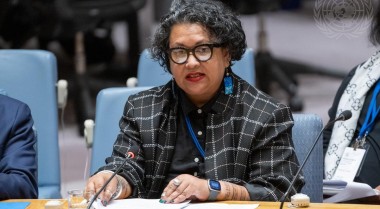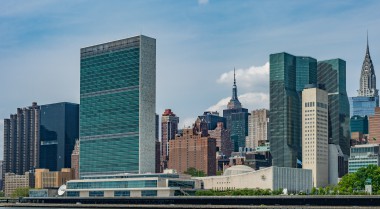
The UN's capacity for supporting member states' national prevention strategies: Assessing practical capabilities
The prevention and peaceful settlement of disputes is the raison d’être of the United Nations. Efforts to do better in preventing conflict and violence have been ongoing within the UN system since its establishment. Under the leadership of Kofi Annan, the early 2000s were marked by remarkable strides towards strengthening the UN's support for national prevention priorities. This piece explores the evolution of these efforts. It examines opportunities and challenges for the UN to support Member States in developing effective national prevention strategies and outlines concrete recommendations for supporting the UN's prevention capacities through the Pact for the Future.
Tracing the evolution and action on conflict prevention within the UN
In 2001, then UN Secretary-General Kofi Annan called for 'NGOs with an interest in conflict prevention to organise an international conference on the role of civil society in conflict prevention', leading to the establishment of the Global Partnership for the Prevention of Armed Conflict (GPPAC) with the goal to support the UN and its Member States in advancing prevention action globally. Subsequently, the 2003 Report of the UN Secretary-General on Conflict Prevention inspired Member States to come together to adopt a General Assembly resolution on the prevention of armed conflict. However, since the last report of the Secretary-General on conflict prevention in 2006, there has been a gap in comprehensive reporting on the issue.
Building on these early initiatives, the UN continued its efforts to advance conflict prevention almost a decade later. In 2015, in response to the UN Security Council resolution 2171 (2014), the Secretary-General presented a report to the Security Council called 'A Collective Recommitment'. Subsequently, in 2018, the Secretary-General outlined the Reform of the UN peace and security pillar in another report, which included many reforms relevant to prevention.
Identifying challenges and opportunities to advance conflict prevention
These UN resolutions and reports provide a wealth of insights that form the foundation for future action, especially through the Pact for the Future. Two key themes emerge. First, the fundamental commitment to conflict prevention and second, the persisting fragmentation within the UN's prevention ecosystem.
The raison d’être of the United Nations (A/72/525, para. 1) emphasises the importance of preventing and peacefully settling disputes. This fact is indisputable and agreed upon in many resolutions of all intergovernmental bodies beyond those we analysed in this piece. However, this noble message lacks actionable specifics, hindering effective implementation.
Despite recognising that 'the UN system possesses the significant technical expertise to support national prevention priorities that are spread out across various parts of the UN system and at different levels' (A/RES/57/337, OP 3), there is a strong sense of recognition and agreement among Member States, the UN and civil society that the UN prevention ecosystem remains fragmented. Previous reports highlighted the existence of various coordination mechanisms addressing specific sectors of conflict prevention but failed to establish a cohesive, overarching strategy for the UN to support the prevention priorities of its Member States. For instance, in 2006, the UN Secretary-General stated that 'several coordination mechanisms exist in the UN system that address specific sectors related to conflict prevention, but they have fallen short of providing a coherent, overarching strategy, both in the field and at Headquarters' (A/60/891, para 92). In 2018, the UN Secretary-General again stated that 'the fragmentation of efforts across the United Nations system contributes to undermining the Organization's ability to respond to crises and conflicts early and effectively' (A/72/525, para. 2). This consistency is concerning.
Member States have made some calls and strides towards stronger prevention action by the UN. However, the call for 'a comprehensive conflict prevention strategy' echoed by the Security Council in S/RES/1366 (OP6) remains unfulfilled. Furthermore, the UN General Assembly asked for a system-wide coherence 'between special political missions and the United Nations system, including the importance of close cooperation between special political missions, peacekeeping operations and UN country teams for maintaining sustainable peace, conflict prevention and conflict resolution' (A/RES/75/100, PP13; A/RES/76/83, PP15; A/RES/77/127, PP15). Despite these resolutions, recent research conducted by GPPAC in Sudan reveals a lack of processes to advance such coherence.
Navigating towards practical action on conflict prevention
In 2023, the Secretary-General's New Agenda for Peace (NA4P) encouraged 'a more deliberate and explicitly universal approach to the prevention of conflict and violence.’ He offered Member States seeking to establish or strengthen national infrastructures for peace 'a tailor-made package of support and expertise'. However, it remains unclear how the UN will effectively support Member States in developing national prevention strategies, particularly given that the persistent challenges identified in previous years have yet to be addressed.
In the absence of a unified approach to conflict prevention, the UN will not be able to adequately assist its Member States in developing national prevention strategies and infrastructures for peace.
The upcoming Summit of the Future and its action-oriented outcome document (the Pact for the Future) offer a platform for Member States to renew their commitment and take concrete actions toward effectively fulfilling the purposes of the UN as outlined in its Charter.
Recommendations for strengthening the UN prevention ecosystem through the Pact of the Future
- Member States could request the UN Secretary-General to submit an updated detailed review of the capacity of the United Nations system to deliver on conflict prevention. This review should encompass an assessment of existing mechanisms, gaps in implementation, and recommendations for strengthening the UN's conflict prevention architecture in support of Member States’ national prevention priorities.
- Member States could provide more concrete guidance to the UN on strengthening its conflict prevention architecture. For example, Member States can call upon the UN Secretary-General to develop 'a comprehensive conflict prevention strategy' (S/RES/1366, OP6) and appoint a focal point for prevention with the UN Department of Peacebuilding and Political Affairs to devise such a strategy and coordination mechanism that will effectively bring the UN prevention expertise together (A/RES/57/337, OP 3) in support of Member States willing to develop national prevention strategies or infrastructures for peace.
- Member States could share progress and seek support for their prevention activities by utilising the convening role of the Peacebuilding Commission or developing a dedicated convening space under the auspices of the UN General Assembly.
As we approach the Summit of the Future in September 2024, it's crucial to recognise that what we outline and propose isn't groundbreaking; it all derives from the agreed language of the UN Security Council and General Assembly resolutions. However, the significance lies in the Summit's aim to build a new multilateral system that actively follows through on these existing policy commitments. With the Summit on the horizon, it's our moment to capitalise on this opportunity and translate these commitments into meaningful and concrete action.



